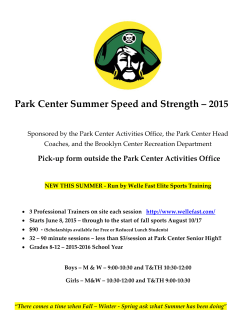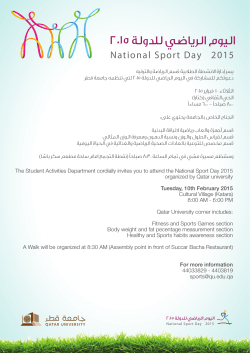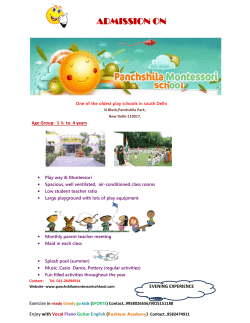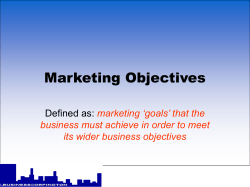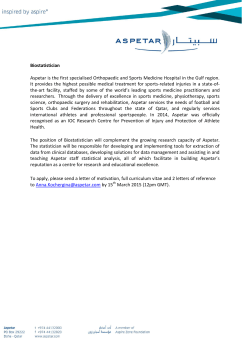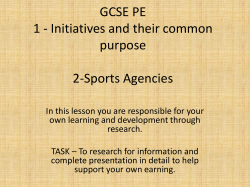
The study of musculoskeletal injuries in athletes from Târgu Mureș
Palestrica of the third millennium – Civilization and Sport Vol. 16, no. 4, October-December 2015, 342–346 The study of musculoskeletal injuries in athletes from Târgu Mureș Studiu privind traumatismele osteoarticulare la sportivii din Târgu Mureş Flaviu-Stelian Duşa, Dana Bădău University of Medicine and Pharmacy, Târgu Mureş, Department of Human Movement Sciences Abstract Background. Although exercising is beneficial to the human body, it can also have a negative impact on the quality of life. Traumatic injuries and osteoarticular overstressing in a sportsman can be the most important negative effects of sports. Aims. This study aims to describe osteoarticular traumas, recovery techniques and time needed to achieve athletic fitness. Methods. We conducted a retrospective observational clinical study in a group of 29 sportsmen. They completed an eightitem questionnaire and the obtained data were processed by the aid of the SPSS20 software program. Results. The most affected anatomical regions were the joints: the knee in 62.1%, followed by the elbow in 17.3% and the ankle in 13.8%. 17 (58.7%) sportsmen suffered from sprain type injuries, 7 (24.1%) from joint dislocation, 4 (13.8%) were diagnosed with fractures, and one (3.4%) with muscle strain. The average recovery time of the studied group following injury was 12.83 weeks, thus for footballers 13.07 weeks and for volleyball players 12.57 weeks. The recorded values of tvalue for all items were superior to tcritical for p <0.05, and the differences of the obtained results were statistically significant, which contributes to the rejection of the null hypothesis. The r-Pearson index was 0.808, highlighting a strong correlation between age and the duration of exercising. Correlation was good and statistically significant between the duration of recovery and regaining full fitness; r=0.556 and pcorrelation=0.002 for p <0.01. Conclusions. Musculoskeletal injuries are common in athletes from Târgu Mureș and are frequently located at the level of the knee, ankle and elbow joints. Medical rehabilitation outlines a good therapeutic conduct, thus contributing to the regaining of full fitness in a relatively short time. Keywords: sport, musculoskeletal trauma, medical rehabilitation, full fitness. Rezumat Premize. Pe lângă beneficiile aduse organismului, sportul poate avea un impact negativ asupra calităţii vieţii. Principalul efect negativ al sportului este reprezentat de traumatisme şi suprasolicitările osteoarticulare la care este supus sportivul. Obiective. Studiul îşi propune descrierea traumatismelor osteoarticulare, metodologia de recuperare precum şi timpul necesar ajungerii la forma sportivă. Metode. Am efectuat un studiu clinic, observaţional, retrospectiv, pe un lot de 29 de sportivi. Aceştia au completat un chestionar cu 8 itemi, iar datele obţinute au fost prelucrate în programul SPSS20. Rezultate. Cea mai afectată regiune anatomică a fost articulaţia genunchiului 62,1%, urmată de articulaţia cotului 17,3% şi glezna 13,8%. La 17 (58,7%) dintre subiecţi, traumatismul a fost de tip entorsă, 7 (24,1%) au suferit luxații, 4 (13,8%) au fost diagnosticaţi cu fracturi și 1 (3,4%) cu întindere musculară. Durata repausului a eșantionului după accidentare a fost de 12,83 săptămâni, astfel pentru grupa de fotbal 13,07 saptamâni, iar pentru cea de volei 12,57 saptamâni. Valorile înregistrate de tvalue, pentru toți itemii, sunt superioare tcritic, pentru p<0.05, iar pvalue evidențiază o semnificație puternică a rezultatelor, ceea ce contribuie la respingerea ipotezei nule. Indicele r-Pearson a fost 0,808, evidențiind o corelație puternică între vârstă și durata practicării. Corelația a fost bună și semnificativ statistică între durata recuperării și durata reintrării în formă sportivă, r fiind 0,556, iar pcorrelation 0,002 pentru p<0,01. Concluzii. Traumatismele osteoarticulare sunt frecvente la sportivii din Târgu Mureș și se localizează frecvent la nivelul articulaţiei genunchiului, gleznei și cotului. Recuperarea medicală determină o conduită terapeutică bună, contribuind la intrarea în forma sportivă într-un interval de timp relativ scurt. Cuvinte cheie: sport, traumatisme osteoarticulare, recuperare medicală, formă sportivă. Received: 2015, June 3; Accepted for publication: 2015, June 28; Address for correspondence: University of Medicine and Pharmacy, Târgu Mureş, 38 Gheorghe Marinescu St., 540139, Phone 0754670730, Romania E-mail: flaviu.dusa@umftgm.ro, dusa.flaviu@gmail.com Corresponding author: Flaviu-Stelian Duşa flaviu.dusa@umftgm.ro, dusa.flaviu@gmail.com Copyright © 2010 by “Iuliu Haţieganu” University of Medicine and Pharmacy Publishing 342 The study of musculoskeletal injuries in athletes from Târgu Mureș Introduction Besides its benefits in maintaining a healthy body, sports can have a negative impact on the quality of life. Athletes often have to cope with competition anxiety, poor teamwork, psychological and physical stress. The main negative effects of sports undergone by athletes are by far trauma and overstrain of the osteoarticular system. These injuries of the body affect the athletes’ quality of life by inducing emotional and physical disabilities ranging from diminished physical performance to permanent abandonment of sports activities (Garrick & Requa 2003; Wiese-Bjornstal, 2010; Deroche et al., 2012; Schwab Rees et al., 2012). Sport rehabilitation is a delicate issue that must be continuously improved through interdisciplinary collaboration (Walker et al., 2007). Musculoskeletal injuries are common in athletes. They adversely affect subsequent sport and physical activities. An effective medical recovery plan applied by a multidisciplinary team under the tutelage of a sports medicine physician can have a positive influence on recovery activities and on the quality of life of athletes who have suffered musculoskeletal traumas (Monticone et al., 2014). A very important aspect of sport rehabilitation is to identify risk factors that lead to injury. Tyler et al. (2014) show that the identification of risk factors is essential especially in case of pelvic trauma and lower limb injuries. These factors can have a somatic or psychic origin or can be external factors such as playing conditions or the quality of training. The medical education of athletes, which is an essential issue, has received more and more attention lately. This has a role in prevention, recovery management, as well as in the athletes’ quality of life regarding sport activities and social behavior following musculoskeletal trauma (Diamond & Solomon, 2014). Sports practice shows a rising trend, which inevitably leads to an increasing number of sport accidents and implicitly, to high economic costs. Reducing these costs gives rise to the need to implement prevention strategies achieved through health education carried out by a multidisciplinary team (Öztürk & Kılıç, 2013). There are numerous studies on the incidence of sport traumas, which help in raising the athletes’ awareness about the importance of training and the process of sport recovery and in particular, about the risks athletes are exposed to according to the specificity of the sport they practice. Thus, a study conducted in athletes of the Great Britain’s Olympic team shows that 27 (39%) suffered from various injuries during the Winter Olympic Games, in 2014, and the most frequent location of injuries was represented by the lower extremities (Palmer-Green & Elliott, 2015). Harvey Kelly et al. (2014), in a study performed in 80 patients with preexisting osteoarticular trauma, found a significant decrease in the frequency of sports practice and a diminished performance. This decrease was predominantly observed in those who suffered any trauma at the level of the lower extremity. Volleyball players frequently suffer from patellar tendinopathy. De Vries et al. (2014) find this condition in 13% of athletes such as volleyball and basketball players. According to Barber Foss et al. (2014), volleyball is the second sport in generating traumas in females. It is known that the incidence of injuries in volleyball players is directly related to the male gender, the duration of training and the degree of participation in competitions. Bahr & Bahr (2014) observed a correlation between these factors and the frequency of jumps during both training and competition; young males jump more often than young females (62.2 jumps/h for boys and 41.9 jumps/h for girls). A long-term negative effect of volleyball is represented by glenohumeral internal rotation deficit. Interestingly, this issue in women is strictly linked to the performance level, while in men this is related to the dominant arm and the presence of a history of trauma at this level (Hadzic et al., 2014). Objectives This study aims to determine the incidence of osteoarticular traumas and the methodology for recovery in athletes from Târgu Mureș. We also aimed to identify those sports that frequently expose athletes to trauma, the anatomical regions exposed to injuries and the type of osteoarticular traumas. Hypothesis During this study, we started from the hypothesis that by applying a specific methodology for osteoarticular traumas in our athletes, recovery can be optimized. Material and methods This research was conducted with the approval of the Ethics Committee of the University of Medicine and Pharmacy, Târgu Mureș. All subjects included in the study were informed about the purpose of this research and the methods of dissemination; subsequently, the whole group agreed to participate in the study and gave their informal consent for the publication of the obtained data. Research protocol a) Period and place of the research The study was carried out in the period 1 October - 1 November 2014 in the sports clubs and sports associations of Târgu Mureș and in the University Sports Club of the University of Medicine and Pharmacy, Târgu Mureș. b) Subjects and groups We conducted a retrospective observational clinical trial in a group of 29 athletes, age ± SD = 20 ± 3.981, of which 15 male football players (N), age ± SD = 2.093 ± 3.812, and 14 female volleyball players (N), age ± SD = 18.71 ± 3.9625. All study subjects are involved in junior and senior competitions. c) Tests applied In the framework of this study, we applied a nonstandardized questionnaire comprising 10 items and two questions for identifying personal data: gender and age. The questionnaire was applied individually, and the responses were included in tables in order to be statistically processed for both the entire sample and for the two groups of sports: football and volleyball. Name of the questionnaire – The quality of life of athletes from Targu Mureș following osteoarticular strain 343 Flaviu-Stelian Duşa & Dana Bădău or injuries. The questionnaire comprised the following items: 1. Practiced sport/sports - type and duration 2. Have you suffered any bone or joint injuries while practicing a sport? Specify the injured part of the body 3. Specify the medical diagnosis 4. Have you undergone medical rehabilitation after the accident? 5. How long did you have to stop practicing sports after the accident? 6. Do you think that this accident has negatively influenced your sports career? 7. How often do you experience pain in the injured body part while resting? 8. How long after the accident did you have to stop exercising? d) Statistical processing The study used the method of the survey based on a non-standardized questionnaire developed by us according to the aimed objectives and on the statistical-mathematical method for processing data and highlighting relevant aspects. The obtained data were statistically processed with the IBM SPPS Statistics 20 software for Windows, which was designed to calculate the following statistical indicators: arithmetic mean, standard deviation (SD), Student t test (t), threshold of significance (pvalue), Pearson’s correlation coefficient (r), significance threshold of the correlation value r (pcorrelation). For this study, the significance threshold of p <0.05 was considered relevant. Table III Descriptive statistics according to the different groups of sports. Group Football Volleyball N 15 14 Item 3. Specify the medical diagnosis (Table V). Item 4. Have you undergone medical rehabilitation after the accident? For how long? (Tables VI, VII). Table VI Number of weeks of recovery after the accident. Statistical indicators Sample Group Football Volleyball % Football N Volleyball % Volleyball Sample 29 15 51.7 14 48.3 Statistical indicators Sample N 29 Mean 10.17 SD 4.80 t 11.404 p .000 SD 6.84 t 3.555 p .001 N 15 14 Mean 4.00 5.0714 SD 3.873 9.16905 Table VIII Duration of rest after the accident. Statistical indicators Sample N 29 Mean 12.83 SD 13.45 t 5.135 p .000 Table IX Descriptive statistics according to the sports groups. Group Football Volleyball Table II Duration of practice. Mean 4.52 Item 5. How long did you have to stop practicing sports after the accident? (weeks of rest) (Tables VIII, IX). Table I The percentage of subjects according to the practiced sport. N Football N 29 Table VII Descriptive statistics according to the sports groups. Item 1. Practiced sport/sports - type and duration (Tables I, II, III). N SD 5.527 2.75860 Item 2. Have you suffered any bone or joint injuries while practicing a sport? Specify the injured part of the body (Table IV). Results Statistical indicators Mean 12.13 8.0714 N 15 14 Mean 13.07 12.5714 SD 14.538 12.73224 Item 6. Do you think that this accident has negatively influenced your sports career? (Table X). Table IV The number of sports injuries and the traumatized region. Group Football Volleyball Sample N 4 1 5 Elbow % 28.6 6,7 17.3 N 8 10 18 Knee % 57.2 66,6 62.1 N 1 3 4 Ankle % 7.1 20 13.8 Metatarsals N % 1 7.1 0 1 3.4 N 1 1 Thigh % 0 6.7 3.4 N 14 15 29 Total % 48.3 51.7 100 Table V The results of the medical diagnosis. Group Football Volleyball Sample N 2 2 4 Fractures % 14.3 13.3 13.8 344 Sprain type injuries Joint dislocation N % N % 8 57.2 4 28.5 9 60 3 20 17 58.7 7 24.1 Muscle tear N % 0 1 6.7 1 3.4 N 14 15 29 Total % 48.3 51.7 100 The study of musculoskeletal injuries in athletes from Târgu Mureș Table X The percentage of the negative influence of accidents on sports career. Group Football Volleyball Sample N 5 6 11 Yes % 33.3 42.9 37.9 N 10 8 18 No % 66.7 57.1 62.1 N 15 14 29 Total % 51.7 48.3 100 Item 7. How often do you experience pain in the injured body part while resting? (Table XI) Table XI The percentage of aches and pains in the body parts that were injured while resting. Group Football Volleyball Sample N 4 7 11 Yes % 26.7 50 37.9 N 11 7 18 No N 73.3 50 62.1 N 15 14 29 Total % 51.7 48.3 100 Item 8. How long after the accident did you have to stop exercising? (Tables XII, XIII) Table XII Duration of regaining full fitness. Statistical indicators Sample N 29 Mean 22.21 SD 15.027 t 7.958 p .000 Table XIII Descriptive statistics according to the sports groups. Group Football Volleyball N 15 14 Mean 27.47 16.5714 SD 16.826 10.73968 Table XIV Correlation between age and the duration of sports practice. Groups Age – duration of practice Pair 1 r p .808** .000 **Correlation is significant at the 0.01 level (2-tailed) volleyball players 8.07 ± 2.75 years. The most affected anatomical region was the knee 62.1%, followed by the elbow 17.3%, and the ankle 13.8%. In the group of football players, the proportion of the injured areas was 57.2% in the knee joint and 28.6% in the elbow joint, and in the case of volleyball players, the major traumas were localized in the knee 66.7% and in the ankle 20%. 17 (58.7%) of the surveyed subjects suffered from sprain type injuries, 7 (24.1%) from joint dislocations, 4 (13.8%) from fractures, and 1 (3.4%) from muscular strain. Regarding the duration of recovery, the group of footballers needed 4 weeks to recover, the group of volleyball players 5 weeks, and the average recovery time of the sample was 4.52 weeks. The duration of rest after injury was 12.83 weeks in the sample, thus in the group of footballers 13.07 weeks and in the group of volleyball players 12.57 weeks. Regarding the assessment of the influence of accidents on their sports careers, the group of footballers declared in a proportion of 66.7% and the group of volleyball players in 57.1% that these did not have a negative effect on their professional development in sports. The sample group needed on average 22.21 weeks to regain full fitness. The recorded values of tvalue were superior for all items to tcritical, p <0.05, and pvalue highlights a high significance of the obtained results, which contributes to the rejection of the null hypothesis and confirms the research hypothesis. The r-Pearson correlation value (calculated in Table XIV) was 0.808, which suggests a strong correlation between age and the duration of practice, p <0.01. In the case of the correlation between the duration of treatment and the duration of recovery, r=0.273, which reflects a relatively good correlation, but the differences were not statistically significant (see Table XV). The correlation between the duration of recovery and the duration of regaining full fitness was good and statistically significant, r is 0.556 and p = 0.002 for p <0.01 (Table XVI). Conclusions Table XV Correlation between the duration of treatment and the duration of recovery. Pair 1 Groups r Duration of treatment - duration of recovery .273 p .152 Table XVI Correlation between the duration of recovery and the duration of regaining full fitness. Pair 1 Groups Duration of recovery – duration of regaining full fitness r .556** p .002 1. The current study reveals that the incidence of osteoarticular traumas is higher in the second decade of life, and their frequency affects more females than males. 2. In our study, the most common type of injury is sprain, especially at the level of the knee joint, with a higher incidence among volleyball players compared to footballers. 3. This research highlights the fact that most athletes undergo good quality medical rehabilitation, taking on average 22 weeks to reach the desired fitness to practice sports again. **Correlation is significant at the 0.01 level (2-tailed) Conflicts of interests There were no conflicts of interests. Discussions In our study, of all 29 investigated athletes, 51.7% were footballers and 48.3% volleyball players. The duration of sports practice ± SD of the sample was 10.17 ± 4.80, in the case of footballers 12.13 ± 5.52 years and in case of Acknowledgments The authors thank all participants and the managers of the institutions involved for understanding and agreeing to participate in this study. 345 Flaviu-Stelian Duşa & Dana Bădău References Bahr MA, Bahr R. Jump frequency may contribute to risk of jumper’s knee: a study of interindividual and sex differences in a total of 11,943 jumps video recorded during training and matches in young elite volleyball players. Br J Sports Med. 2014;48(17):1322-1326. Barber Foss KD, Myer GD, Hewett TE. Epidemiology of basketball, soccer, and volleyball injuries in middle-school female athletes. Phys Sportsmed. 2014;42(2):146-153. de Vries AJ, van der Worp H, Diercks RL, van den AkkerScheek I, Zwerver J. Risk factors for patellar tendinopathy in volleyball and basketball players: A survey-based prospective cohort study. Scand J Med Sci Sports. 2015;25(5):678-684. doi: 10.1111/sms.12294. Deroche T, Stephan Y, Woodman T. Psychological Mediators of the Sport Injury-Perceived Risk Relationship. Risk Analysis, 2012;32(1):113-121. Diamond AB, Solomon GS. Modifying factors in sports-related concussion: dangerous style of play. Phys Sportsmed. 2014;42(3):20-25. Garrick JG, Requa RK. Sports and fitness activities: the negative consequences. J Am Acad Orthop Surg, 2003;11:439-443. Hadzic V, Sattler T, Veselko M, Markovic G, Dervisevic E. Strength asymmetry of the shoulders in elite volleyball players. J Athl Train. 2014;49(3):338-344. Harvey-Kelly KF, Kanakaris NK, Obakponovwe O, West R, Roberts CS, Giannoudis PV. The impact of traumatic pelvic fractures on sporting activity and quality of life. J R Nav Med Serv. 2014;100(1):73-80. Schwab Reesea LM, Pittsingerb R, Yanga J. Effectiveness of psychological intervention following sport injury. J Sport Health Sci, 2012;1(2):71-79. Monticone M, Ambrosini E, Rocca B, Magni S, Brivio F, Ferrante S. A multidisciplinary rehabilitation programme improves disability, kinesiophobia and walking ability in subjects with chronic low back pain: results of a randomised controlled pilot study. Eur Spine J. 2014;23(10):2105-2113. Öztürk S, Kılıç D. What is the economic burden of sports injuries? Eklem Hastalık Cerrahisi. 2013;24(2):108-111. Palmer-Green D, Elliott N. Sports injury and illness epidemiology: Great Britain Olympic Team (TeamGB) surveillance during the Sochi 2014 Winter Olympic Games. Br J Sports Med. 2015;49(1):25-29. Tyler TF, Fukunaga T, Gellert J. Rehabilitation of soft tissue injuries of the hip and pelvis. Int J Sports Phys Ther. 2014;9(6):785-797. Walker N, Thatcher J, Lavallee D. Psychological responses to injury in competitive sport: a critical review. J R Soc Promot Health. 2007;127(4):174-180. Wiese-Bjornstal DM. Psychology and socioculture affect injury risk, response, and recovery in high-intensity athletes: a consensus statement. Scand J Med Sci Sports. 2010;20(Suppl 2):103-111. 346
© Copyright 2025
